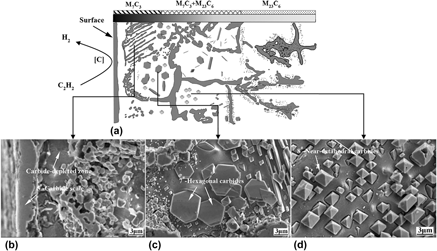Crossref Citations
This article has been cited by the following publications. This list is generated based on data provided by
Crossref.
Li, Wei
Sun, Zhenduo
Deng, Hailong
Zhang, Zhenyu
and
Sakai, Tatsuo
2015.
Interior crack initiation and growth behaviors and life prediction of a carburized gear steel under high cycle fatigue and very high cycle fatigue.
Journal of Materials Research,
Vol. 30,
Issue. 14,
p.
2247.
Szkodo, Marek
and
Gajowiec, Grzegorz
2016.
Studies of the mechanism of metal dusting of 10CrMo9-10 steel after 10 years of operation in the semi-regenerative catalytic reformer.
Corrosion Science,
Vol. 102,
Issue. ,
p.
279.
Guo, Jingfeng
Cheng, Congqian
Li, Huifang
Zhao, Jie
and
Min, Xiaohua
2017.
Microstructural analysis of Cr35Ni45Nb heat-resistant steel after a five-year service in pyrolysis furnace.
Engineering Failure Analysis,
Vol. 79,
Issue. ,
p.
625.
Guo, Jingfeng
Cao, Tieshan
Cheng, Congqian
Meng, Xianming
and
Zhao, Jie
2018.
The Relationship Between Magnetism and Microstructure of Ethylene Pyrolysis Furnace Tubes after a Long-term Service.
Microscopy and Microanalysis,
Vol. 24,
Issue. 5,
p.
478.
Guo, Jingfeng
Cao, Tieshan
Cheng, Congqian
Meng, Xianming
and
Zhao, Jie
2018.
Microstructure evolution and mechanical properties degradation of HPNb alloy after a five-year service.
Materials Research Express,
Vol. 5,
Issue. 4,
p.
046509.
Yin, Longcheng
Wang, Tingjian
Ma, Xinxin
Fu, Zhongyuan
Hao, Guodong
Li, Liuhe
and
Wang, Liqin
2019.
Pre-Coated Fe–Ni Film to Promote Low-Pressure Carburizing of 14Cr14Co13Mo4 Steel.
Coatings,
Vol. 9,
Issue. 5,
p.
304.
Guo, Jingfeng
Cao, Tieshan
Cheng, Congqian
Meng, Xianming
and
Zhao, Jie
2020.
Effect of carburization (pyrolysis furnace tube main failure factor) on the microstructure and properties of HPNb alloy tube.
Engineering Failure Analysis,
Vol. 115,
Issue. ,
p.
104610.
Thorseth, Matthew A.
Tocha, Ewa
Davis, Mark
Corthals, Steven
Korf, Stefanus
Novák, Libor
Mahel, Vojtěch
and
Bukvišová, Kristýna
2021.
In-Situ SEM Observation of the Oxidation and Reduction of Hydrocarbon Cracking Coil Materials.
SSRN Electronic Journal ,
Thorseth, Matthew A.
Tocha, Ewa
Davis, Mark
Corthals, Steven
Korf, Stefanus
Novák, Libor
Mahel, Vojtěch
and
Bukvišová, Kristýna
2021.
In-Situ SEM Observation of the Oxidation and Reduction of Hydrocarbon Cracking Coil Materials.
SSRN Electronic Journal ,
CHEN, Fan
LI, Guangxi
ZHAO, Bo
and
BIE, Wenbo
2021.
Thermomechanical coupling effect on characteristics of oxide film during ultrasonic vibration-assisted ELID grinding ZTA ceramics.
Chinese Journal of Aeronautics,
Vol. 34,
Issue. 6,
p.
125.
Luan, Ngo Huynh Kinh
Okuyama, Tetsuya
Nakayama, Masaru
Mizuno, Kuniaki
and
Koizumi, Koreaki
2022.
Influence of Nb Addition on Microstructure and Creep Property of Heat-Resistant Cast Steel in Vacuum Carburizing and Quenching.
MATERIALS TRANSACTIONS,
Vol. 63,
Issue. 11,
p.
1557.
Fuyang, Chengming
Gong, Jianming
Wang, Xiaowei
Panwisawas, Chinnapat
and
Chen, Bo
2022.
A physics-based life prediction model of HP40Nb heat-resistant alloy in a coupled creep-carburisation environment.
Materials Science and Engineering: A,
Vol. 860,
Issue. ,
p.
144260.
Dai, Yanzhang
Kang, Lixia
Han, Shun
Li, Yong
Liu, Yu
Lei, Simin
and
Wang, Chunxu
2022.
Surface Hardening Behavior of Advanced Gear Steel C61 by a Novel Solid-Solution Carburizing Process.
Metals,
Vol. 12,
Issue. 3,
p.
379.
Fuyang, Chengming
Gong, Jianming
Geng, Luyang
Ye, Dongdong
and
Guo, Xiaofeng
2023.
On the creep behaviour of HP40Nb alloy with high-temperature carburisation damage.
International Journal of Pressure Vessels and Piping,
Vol. 206,
Issue. ,
p.
105066.





